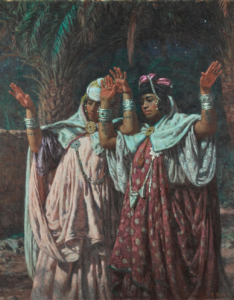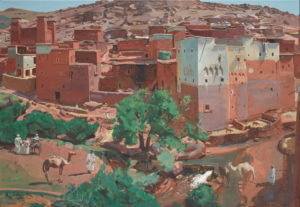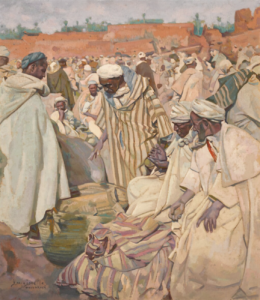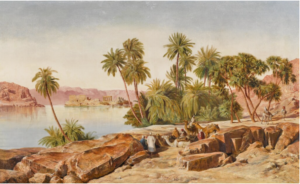
Dancers in a Moonlit Palm Grove by Nasreddine Dinet
On Tuesday, October 24, Sotheby’s London hosted one of its Orientalist sales, featuring fifty-five paintings by various nineteenth- and twentieth-century European and American artists. For the lots that sold, Sotheby’s experts did a rather good job predicting which paintings would do well once they crossed the block. Expected to be the top lot, Dancers in a Moonlit Palm Grove by Nasreddine Dinet was used by Sotheby’s for the sales promotional material. The work measures 58 ¼-by-46 inches and shows two women in the middle of a dance. The subjects have their arms and faces decorated with tattoos, while the palms of the hands are red with henna dye. This and their jewelry indicate that they are Berbers, the traditionally nomadic people of North Africa, primarily concentrated in Algeria and Morocco. Though not as prolific as other Orientalist artists like Jean-Léon Gérôme, Dinet was one of the cornerstones of Orientalist painting in late nineteenth- and early twentieth-century France. Unlike other painters who based their works on travels to North Africa, Arabia, the Levant, and Turkey, Dinet completely embedded himself into a community of Berbers in Algeria. By 1903, he spent nine months out of the year in a house he bought in the town of Bou Saâda, about 125 miles southeast of Algiers. By the time he created Dancers in a Moonlit Palm Grove, he had already converted to Islam and changed his name to Nasreddine from his French birth name, Alphonse-Étienne. His popularity among people in both France and Algeria stemmed from his ability to transcend exoticism and focus on detail, almost to the point of his work being anthropology through painting. And the three works offered at Sotheby’s on Tuesday were no exception. Sotheby's predicted Dancers in a Moonlit Palm Grove to do exceptionally well, with a pre-sale estimate range of £200K to £400K. The Dinet went above and beyond that, with the hammer eventually coming down at £610K / $745.4K (or £774.7K / $946.7K w/p).

The Casbah of Anemiter by Jacques Majorelle
Some of the other top lots in the sale were by the French painter Jacques Majorelle. The sale featured four works by Majorelle, most of them typical for the artist since he tended to focus more on Moroccan life than anything else. His oil-on-hardboard painting The Casbah of Anemiter shows a casbah, or fortress, in the Ounila Valley, about fifty miles southeast of Marrakech. The painting is dated 1950, meaning Majorelle had been living in Marrakech for twenty-seven years by the time he created the work. Expected to sell for between £60K and £80K, The Casbah of Anemiter sold for more than double the high estimate at £165K / $201.6K (or £209.6K / $256.1K w/p).

Market in Marrakech by Jacques Majorelle
Another painting by Majorelle came in joint third place. Coming across the block immediately after The Casbah of Anemiter, Majorelle created the oil painting Market in Marrakech sometime in the early to mid-1940s. Though he was venturing further south into sub-Saharan West Africa by this point in his career, Majorelle continued creating his Moroccan genre paintings. Sharing third place with the Majorelle was a nineteenth-century painting from the other side of North Africa. Edward Lear’s landscape The Island of Philae, above the First Cataract of the Nile is a bit of a time machine on canvas. Philae was an island in the middle of the Nile near the southern Egyptian city of Aswan. Egyptologists and other scholars focused on it because of its ancient temple (the Sotheby’s sale also featured a closer view of the Philae temple through a painting by Carl Werner that I quite liked). However, in 1958, the Egyptian government began planning the construction of a hydroelectric dam near Aswan, which would cause the Nile, south of the dam, to rise and create a reservoir. Egypt and Sudan asked for help relocating the temples and monuments in this area so they would not be lost underwater forever. Between 1972 and 1979, an international team helped move the Philae temple complex from Philae to Agilkia Island on the other side of the dam. Several other famous archaeological sites were preserved this way, including the temples of Abu Simbel. Both Majorelle’s Market in Marrakech and Lear’s Island of Philae achieved a hammer price of £140K / $171.1K (or £177.8K / $217.3K w/p), with the Majorelle exceeding its £80K high estimate. In comparison, the Lear fell just slightly short of its £150K low estimate.

The Island of Philae, above the First Cataract of the Nile by Edward Lear
Other than Majorelle’s Casbah of Anemiter, the only additional surprise of note at Sotheby’s was one of the other paintings by Dinet. Sighting of the Crescent Moon does not show the titular celestial body but rather a crowd gathering on rooftops to spot it. While looking at beautiful natural phenomena is a natural impulse, the crescent moon is an important symbol for the people of North Africa and Muslims in general. In Islam, the holy month of Ramadan starts and ends with the arrival of the crescent moon in the sky, which explains the excitement or awe some of the painting’s subjects are displaying. This particular Dinet painting is rather unassuming, executed with oil paint on a 12-by-10-inch piece of card. Predicted by Sotheby’s specialists to sell for no more than £20K, Sighting of the Crescent Moon sold for exactly double that at £40K / $48.9K (or £50.8K / $62.1K w/p).
Of the fifty-five lots in total, ten of them sold within their estimates, which is about 18%. Nine lots (16%) sold below, while eleven lots (20%) exceeded their estimates. However, it was disappointing to see that twenty-five lots (45%) went unsold, including View of the Bosporus from Üsküdar by François Léon Pieur-Bardin (est. £40K to £60K), And I Will See, Before I Die, the Palms and Temples of the South by Edward Lear (est. £70K to £100K), and The Escort by Rudolf Ernst (est. £80K to £120K). Most of the lots bought in came in the second half of the sale, with sixteen of the last twenty lots failing to meet their reserves. However, partially thanks to the lots that sold over estimate, the sale as a whole actually made more money than expected. All fifty-five lots were predicted to bring in anywhere between £1.45M and £2.3M. The thirty lots that sold made a total of £2.4M / $2.9M.
Sotheby’s London Orientalist Sale
Dancers in a Moonlit Palm Grove by Nasreddine Dinet
On Tuesday, October 24, Sotheby’s London hosted one of its Orientalist sales, featuring fifty-five paintings by various nineteenth- and twentieth-century European and American artists. For the lots that sold, Sotheby’s experts did a rather good job predicting which paintings would do well once they crossed the block. Expected to be the top lot, Dancers in a Moonlit Palm Grove by Nasreddine Dinet was used by Sotheby’s for the sales promotional material. The work measures 58 ¼-by-46 inches and shows two women in the middle of a dance. The subjects have their arms and faces decorated with tattoos, while the palms of the hands are red with henna dye. This and their jewelry indicate that they are Berbers, the traditionally nomadic people of North Africa, primarily concentrated in Algeria and Morocco. Though not as prolific as other Orientalist artists like Jean-Léon Gérôme, Dinet was one of the cornerstones of Orientalist painting in late nineteenth- and early twentieth-century France. Unlike other painters who based their works on travels to North Africa, Arabia, the Levant, and Turkey, Dinet completely embedded himself into a community of Berbers in Algeria. By 1903, he spent nine months out of the year in a house he bought in the town of Bou Saâda, about 125 miles southeast of Algiers. By the time he created Dancers in a Moonlit Palm Grove, he had already converted to Islam and changed his name to Nasreddine from his French birth name, Alphonse-Étienne. His popularity among people in both France and Algeria stemmed from his ability to transcend exoticism and focus on detail, almost to the point of his work being anthropology through painting. And the three works offered at Sotheby’s on Tuesday were no exception. Sotheby's predicted Dancers in a Moonlit Palm Grove to do exceptionally well, with a pre-sale estimate range of £200K to £400K. The Dinet went above and beyond that, with the hammer eventually coming down at £610K / $745.4K (or £774.7K / $946.7K w/p).
The Casbah of Anemiter by Jacques Majorelle
Some of the other top lots in the sale were by the French painter Jacques Majorelle. The sale featured four works by Majorelle, most of them typical for the artist since he tended to focus more on Moroccan life than anything else. His oil-on-hardboard painting The Casbah of Anemiter shows a casbah, or fortress, in the Ounila Valley, about fifty miles southeast of Marrakech. The painting is dated 1950, meaning Majorelle had been living in Marrakech for twenty-seven years by the time he created the work. Expected to sell for between £60K and £80K, The Casbah of Anemiter sold for more than double the high estimate at £165K / $201.6K (or £209.6K / $256.1K w/p).
Market in Marrakech by Jacques Majorelle
Another painting by Majorelle came in joint third place. Coming across the block immediately after The Casbah of Anemiter, Majorelle created the oil painting Market in Marrakech sometime in the early to mid-1940s. Though he was venturing further south into sub-Saharan West Africa by this point in his career, Majorelle continued creating his Moroccan genre paintings. Sharing third place with the Majorelle was a nineteenth-century painting from the other side of North Africa. Edward Lear’s landscape The Island of Philae, above the First Cataract of the Nile is a bit of a time machine on canvas. Philae was an island in the middle of the Nile near the southern Egyptian city of Aswan. Egyptologists and other scholars focused on it because of its ancient temple (the Sotheby’s sale also featured a closer view of the Philae temple through a painting by Carl Werner that I quite liked). However, in 1958, the Egyptian government began planning the construction of a hydroelectric dam near Aswan, which would cause the Nile, south of the dam, to rise and create a reservoir. Egypt and Sudan asked for help relocating the temples and monuments in this area so they would not be lost underwater forever. Between 1972 and 1979, an international team helped move the Philae temple complex from Philae to Agilkia Island on the other side of the dam. Several other famous archaeological sites were preserved this way, including the temples of Abu Simbel. Both Majorelle’s Market in Marrakech and Lear’s Island of Philae achieved a hammer price of £140K / $171.1K (or £177.8K / $217.3K w/p), with the Majorelle exceeding its £80K high estimate. In comparison, the Lear fell just slightly short of its £150K low estimate.
The Island of Philae, above the First Cataract of the Nile by Edward Lear
Other than Majorelle’s Casbah of Anemiter, the only additional surprise of note at Sotheby’s was one of the other paintings by Dinet. Sighting of the Crescent Moon does not show the titular celestial body but rather a crowd gathering on rooftops to spot it. While looking at beautiful natural phenomena is a natural impulse, the crescent moon is an important symbol for the people of North Africa and Muslims in general. In Islam, the holy month of Ramadan starts and ends with the arrival of the crescent moon in the sky, which explains the excitement or awe some of the painting’s subjects are displaying. This particular Dinet painting is rather unassuming, executed with oil paint on a 12-by-10-inch piece of card. Predicted by Sotheby’s specialists to sell for no more than £20K, Sighting of the Crescent Moon sold for exactly double that at £40K / $48.9K (or £50.8K / $62.1K w/p).
Of the fifty-five lots in total, ten of them sold within their estimates, which is about 18%. Nine lots (16%) sold below, while eleven lots (20%) exceeded their estimates. However, it was disappointing to see that twenty-five lots (45%) went unsold, including View of the Bosporus from Üsküdar by François Léon Pieur-Bardin (est. £40K to £60K), And I Will See, Before I Die, the Palms and Temples of the South by Edward Lear (est. £70K to £100K), and The Escort by Rudolf Ernst (est. £80K to £120K). Most of the lots bought in came in the second half of the sale, with sixteen of the last twenty lots failing to meet their reserves. However, partially thanks to the lots that sold over estimate, the sale as a whole actually made more money than expected. All fifty-five lots were predicted to bring in anywhere between £1.45M and £2.3M. The thirty lots that sold made a total of £2.4M / $2.9M.